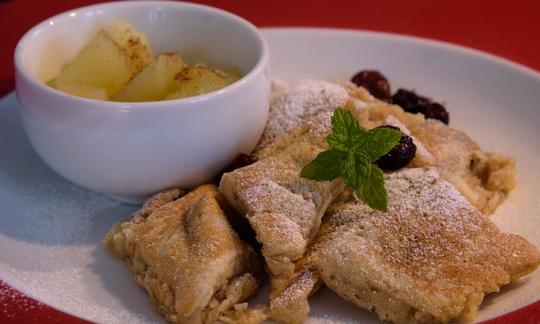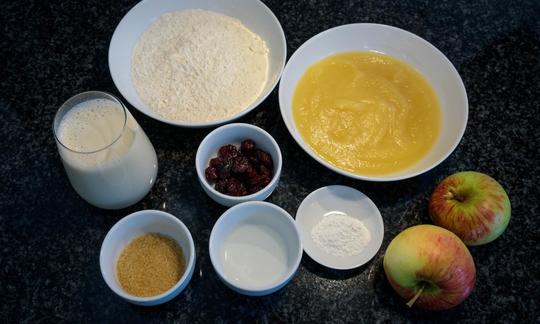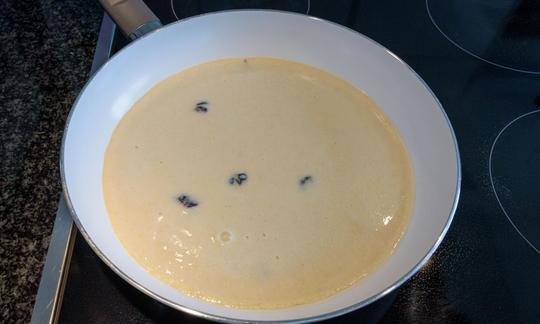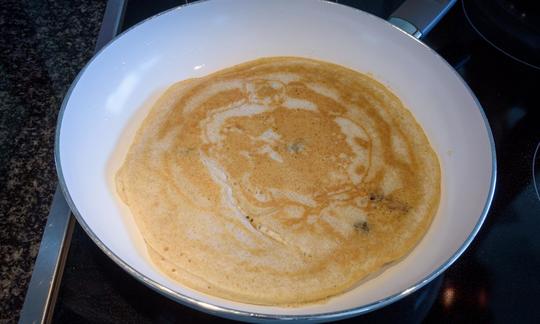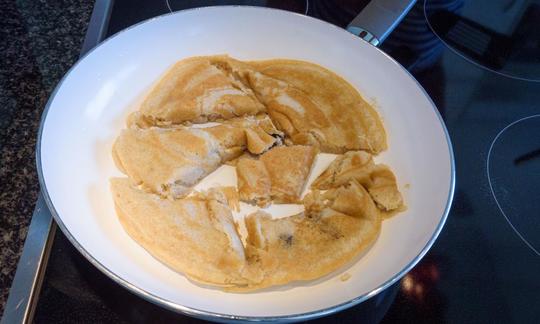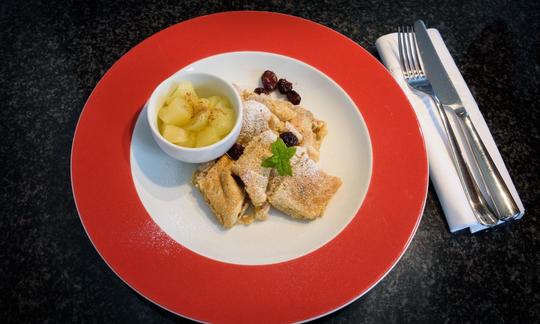Heavenly Kaiserschmarrn with Cranberries
vegan
Ingredients (for servings, )
| For the batter | |
|---|---|
| 6 ½ oz | Wheat flour, wholemeal (organic?) |
| 1 tbsp | Baking powder (baking agent, organic?, vegan?) (0.35 oz) |
| 150 ml | Apple sauce, unsweetened (apple compote, apple puree) (5.5 oz) |
| 1 oz | Brown sugar (raw sugar, whole cane sugar, whole sugar, organic?) |
| 1 dash | Table salt (table salt, raw?, organic?) (0.01 oz) |
| 200 ml | Soy milk with vanilla, (organic?, raw?) (7.3 oz) |
| 1 oz | Cranberries, dried, sweetened (raw?, organic?) |
| 1 tbsp | Coconut oil (coconut oil, coconut fat, organic?, raw?) (0.48 oz) |
| Garnish and serving | |
| 1 tsp | Icing sugar (raw?, organic?) (0.09 oz) |
Equipment
- stand mixer or whisk
- skillet (frying pan)
- stove
Type of preparation
- fry
- blend
Preparation
For the dough
Sieve the flour and combine with the baking powder.Whisk the applesauce, sugar, and salt with a mixer or whisk. Gradually whisk in the flour mixture and soy milk, alternating between the two, until you have a smooth batter. Add the cranberries at the end.
We recommend that you use natural, unenriched soy milk.
The batter should have a thicker, creamy consistency, and shouldn’t be too thin.
Heat the coconut oil in a skillet and pour in half of the batter. Cook about 5 minutes, until the edge takes on a brown color and bubbles appear on the surface.
Flip the Kaiserschmarrn, tear into bite-size pieces, and cook on the other side until golden brown.
Repeat this procedure with the second half of the batter.
Keep the Kaiserschmarrn warm in a 50 °C (120 °F) oven until ready to serve.
Garnish and serving
Arrange the Kaiserschmarrn on plates and sprinkle powdered sugar on top.Kasierschmarrn tastes delicious served alongside apple compote. See our tips on how to make it.
|
Nutritional Information per person
Convert per 100g
|
2000 kcal | |
|---|---|---|
| Energy | 286 kcal | 14.3% |
| Fat/Lipids | 5.5 g | 7.9% |
| Saturated Fats | 3.1 g | 15.6% |
| Carbohydrates (inc.dietary fiber) | 55 g | 20.4% |
| Sugars | 19 g | 21.4% |
| Fiber | 6.0 g | 23.8% |
| Protein/Albumin | 7.9 g | 15.7% |
| Cooking Salt (Na:364.3 mg) | 925 mg | 38.6% |
| Essential micronutrients with the highest proportions | per person | 2000 kcal | |
|---|---|---|---|
| Min | Manganese, Mn | 2.0 mg | 99.0% |
| Elem | Phosphorus, P | 401 mg | 57.0% |
| Min | Selenium, Se | 31 µg | 56.0% |
| Sodium, Na | 364 mg | 46.0% | |
| Prot | Tryptophan (Trp, W) | 0.10 g | 40.0% |
| Min | Copper, Cu | 0.27 mg | 27.0% |
| Prot | Threonine (Thr, T, irreversibly transaminated) | 0.23 g | 25.0% |
| Vit | Vitamin B1 (Thiamine) | 0.27 mg | 24.0% |
| Prot | Phenylalanine (Phe, F) | 0.37 g | 24.0% |
| Prot | Leucine (Leu, L) | 0.52 g | 22.0% |
Detailed Nutritional Information per Person for this Recipe
The majority of the nutritional information comes from the USDA (US Department of Agriculture). This means that the information for natural products is often incomplete or only given within broader categories, whereas in most cases products made from these have more complete information displayed.
If we take flaxseed, for example, the important essential amino acid ALA (omega-3) is only included in an overarching category whereas for flaxseed oil ALA is listed specifically. In time, we will be able to change this, but it will require a lot of work. An “i” appears behind ingredients that have been adjusted and an explanation appears when you hover over this symbol.
For Erb Muesli, the original calculations resulted in 48 % of the daily requirement of ALA — but with the correction, we see that the muesli actually covers >100 % of the necessary recommendation for the omega-3 fatty acid ALA. Our goal is to eventually be able to compare the nutritional value of our recipes with those that are used in conventional western lifestyles.
| Essential fatty acids | per person | 2000 kcal |
|---|---|---|
| Linoleic acid; LA; 18:2 omega-6 | 0.87 g | 9.0% |
| Alpha-Linolenic acid; ALA; 18:3 omega-3 | 0.08 g | 4.0% |
| Essential amino acids | per person | 2000 kcal |
|---|---|---|
| Tryptophan (Trp, W) | 0.10 g | 40.0% |
| Threonine (Thr, T, irreversibly transaminated) | 0.23 g | 25.0% |
| Phenylalanine (Phe, F) | 0.37 g | 24.0% |
| Leucine (Leu, L) | 0.52 g | 22.0% |
| Isoleucine (Ile, I) | 0.27 g | 21.0% |
| Valin (Val, V) | 0.32 g | 20.0% |
| Lysine (Lys, K, irreversibly transaminated) | 0.24 g | 13.0% |
| Methionine (Met, M) | 0.12 g | 13.0% |
| Vitamins | per person | 2000 kcal |
|---|---|---|
| Vitamin B1 (Thiamine) | 0.27 mg | 24.0% |
| Vitamin B6 (pyridoxine) | 0.24 mg | 17.0% |
| Vitamin B3 (Niacin) | 2.6 mg | 16.0% |
| Vitamin B9, B11 (Folate, as the active form of folic acid) | 30 µg | 15.0% |
| Vitamin B2 (Riboflavin) | 0.12 mg | 9.0% |
| Vitamin B5 (Pantothenic acid) | 0.51 mg | 8.0% |
| Vitamin B7 (Biotin, ex vitamin H) | 3.7 µg | 7.0% |
| Vitamin E, as a-TEs | 0.60 mg | 5.0% |
| Vitamin K | 3.2 µg | 4.0% |
| Vitamin C (ascorbic acid) | 0.40 mg | 1.0% |
| Vitamin A, as RAE | 0.54 µg | < 0.1% |
| Essential macroelements (macronutrients) | per person | 2000 kcal |
|---|---|---|
| Phosphorus, P | 401 mg | 57.0% |
| Sodium, Na | 364 mg | 46.0% |
| Magnesium, Mg | 77 mg | 21.0% |
| Potassium, K | 268 mg | 13.0% |
| Calcium, Ca | 65 mg | 8.0% |
| Essential trace elements (micronutrients) | per person | 2000 kcal |
|---|---|---|
| Manganese, Mn | 2.0 mg | 99.0% |
| Selenium, Se | 31 µg | 56.0% |
| Copper, Cu | 0.27 mg | 27.0% |
| Iron, Fe | 2.1 mg | 15.0% |
| Zinc, Zn | 1.3 mg | 13.0% |
| Fluorine, F | 0.00 µg | < 0.1% |
| Iod, I (Jod, J) | 0.00 µg | < 0.1% |
This tasty vegan Kaiserschmarrn (shredded pancakes) with cranberries is a crowd pleaser that even without egg is just as delicious and fluffy as the original.
Origin: Kaiserschmarrn (shredded pancakes) is a dish that is connected with numerous legends. One of these tells that the name came from the Austrian emperor Kaiser Franz Joseph I, who was very fond of this type of pancakes. Kaiserschmarrn is one of the most popular sweet dishes in Austrian cuisine. It is traditionally served with plum compote.
Whole wheat flour: Whole grain products are obtained by grinding the wheat berry (whole grain of wheat). Unlike white flour, whole grain products contain the bran, germ, and endosperm. They therefore have significantly higher levels of fiber, vitamins, and minerals (e.g., iron and magnesium).
Cranberries: Cranberries are related to lingonberries, which have a quite tart flavor. Unlike raisins, dried cranberries have a pleasant tart flavor that goes well with many sweet dishes. In addition, they are a good source of minerals.
Serve with apple compote: Kaiserschmarrn tastes great served alongside homemade apple compote. To make, simply peel 2–3 apples, remove the core, and chop into small pieces. Place in a pot with a few squeezes of lemon juice, 2 tablespoons water, and ½ teaspoon cinnamon and let simmer for about 10 minutes.
Flour substitutes: Instead of whole wheat flour, you can also use any other type of whole grain flour, spelt flour, or plain white flour.
Raisins: You can use raisins in place of the cranberries. However, raisins don’t have the tart flavor that provide a nice contrast in sweet dishes.

